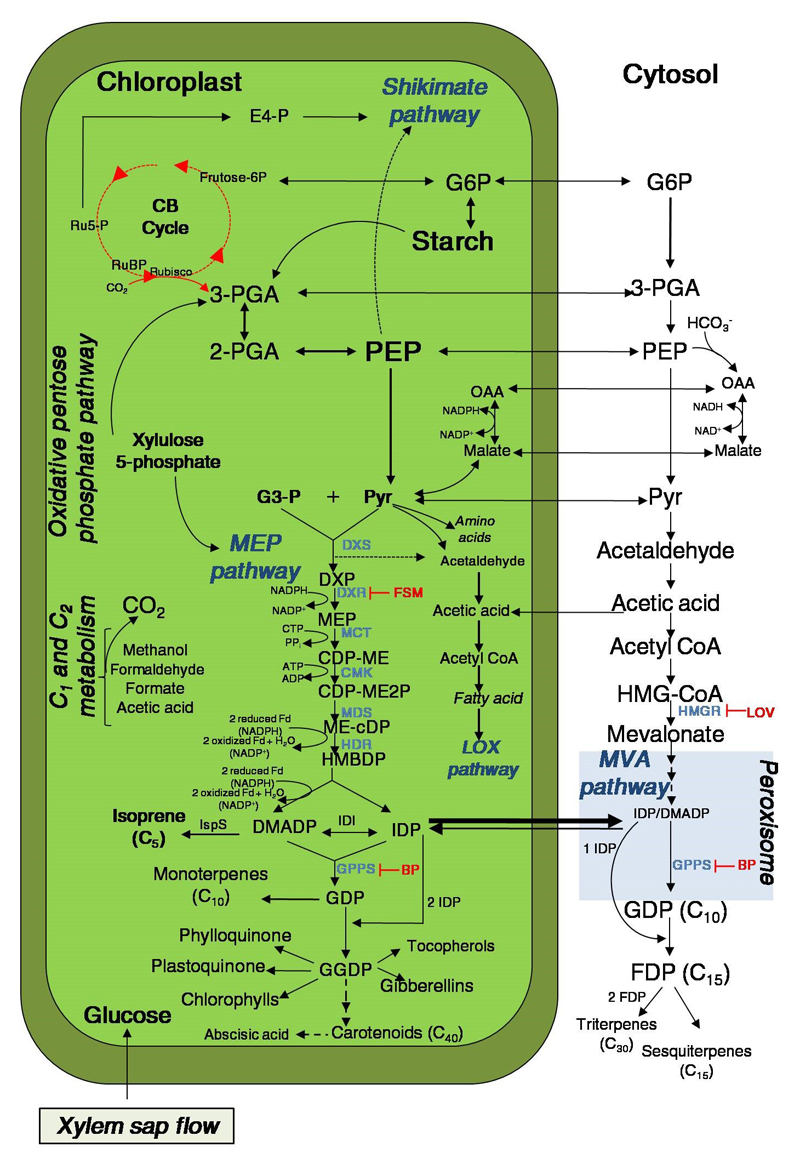Figure 1.
Synthesis of major plant volatile isoprenoids, isoprene and monoterpenes, occurs via the 2-C-methyl-D-erythritol 4-phosphate (MEP) pathway in chloroplast, however other multiple biosynthetic pathways can contribute carbon intermediates to MEP pathway. Due to the compartmental nature of the chloroplast metabolism and cytosol, the intermediate exchange among different pathways is hampered. The key pathways interacting with the MEP pathway are Carbon 1 (C1) metabolic pathway, oxidative pentose pathway, Calvin-Benson (CB) cycle, shikimate pathway, cytosolic glycolysis and mevalonate (MVA) pathway. Potential exchange of intermediates through the plastid membrane is also shown, as well as intermediate carbon partitioning. In addition, biosynthesis of different classes of isoprenoids formed from the same five carbon (C5) precursors in both compartments is shown. Solid-line arrows indicate carbon flow from extra-chloroplast intermediate molecules and exchange of carbon intermediates between the compartments. The inhibitors of the MVA and MEP pathway are shown in red. Fosmidomycin (FMS) inhibits DXR, the enzyme responsible for the formation of MEP from DXP in the MEP pathway [30,89]. Bisphosphonates (BP) inhibitors (e.g. alendronate and zoledronate) are used to inhibit prenyltransferases reactions, suppressing the formation of isoprenoids formed from GDP in chloroplast and cytosol [44,88]. The lovastatin (LOV) (also referred to as mevinolin), is a specific inhibitor of HMGR in the MVA pathway [75,79,87]. Abbreviations: Metabolites: CDP-ME, 4-(cytidine 5’-diphospho)-2-C-methyl-D-erythritol; CDP-ME2P, 2-Phospho-4-(cytidine 5’-diphospho)-2-C-methyl-D-erythritol; DMADP, dimethylallyl diphosphate; E4-P; erythrose 4-phosphate; FDP, farnesyl diphosphate (FDP; C15); GDP, geranyl diphosphate (GDP, C10); geranylgeranyl diphosphate (GGDP, C20); G6P, glucose 6-phosphate; G3-P, glyceraldehydes-3-phosphate; HCO3-, bicarbonate ion; HMBDP, 1-Hydroxy-2-methylbut-2-enyl-butenyl 4-diphosphate; HMG-CoA, 3-hydroxy-3-methyl-glutaryl-coenzyme A; IDP, isopentenyl diphosphate; MEP, 2-C-methyl-D-erythritol 4-phosphate; ME-cDP, 2-C-methyl-D-erythritol 2,4-cyclodiphosphate; OAA, oxaloacetate; PEP, phosphoenolpyruvate; 2-PGA, 2- phosphoglycerate; 3-PGA, 3-phosphoglycerate; RuBP, ribulose-1,5-bisphosphate; Ru5-P, Ribulose 5-phosphate. Enzymes: CMK, 4-(cytidine 5’-diphospho)-2-C-methyl-D-erythritol kinase; DXS, 1-Deoxy-D xylulose 5-phosphate synthase; DXR, 1-Deoxy-D-xylulose 5-phosphate reductoisomerase; HDR, 4-Hydroxy-3-methylbut-2-enyl-diphosphate reductase; HMGR, 3-hydroxy-3-methyl-glutaryl-coenzyme A reductase; IDI, isopentenyl diphosphate isomerase; IspS, isoprene synthase; MCT, 2-C-methyl-D-erythritol 4-phosphate cytidylyltransferase; MDS, 2-C-methyl-D-erythritol 2,4-cyclodiphosphate synthase. Cofactors: ADP, adenosine diphosphate; ATP, adenosine triphosphate; CTP, cytidine triphosphate; NADH, nicotinamide adenine dinucleotide (form reduced); NAD+, nicotinamide adenine dinucleotide (form oxidized); NADPH, nicotinamide adenine dinucleotide phosphate (form reduced); NADP+, nicotinamide adenine dinucleotide phosphate (form oxidized). Additional abbreviations: Fd; ferredoxin-dependent reaction; PPi; pyrophosphate.

